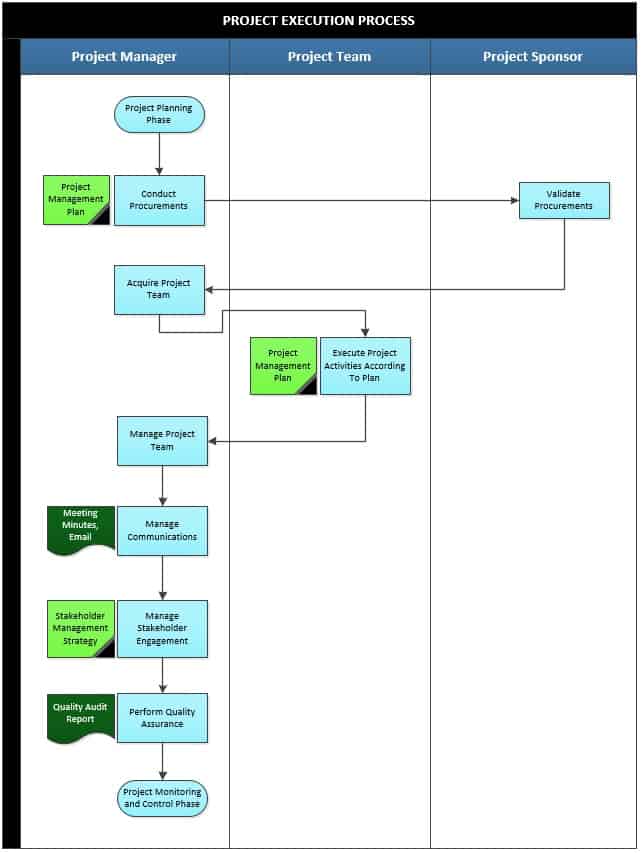Project execution is about actualizing the already designed plan. It involves putting into action all the activities that were set in the previous processes of the project cycle. The project activities are done according to the set plans, sequence and procedures to satisfy the requirements of the project. The purpose of implementing or executing a project is to deliver the expected results. Concerning the span of the project processes, this project execution is the longest and is the one that utilizes a lot of the resources. This process is based on the PMBOK framework and this affirms that it is a proven practice that is applied widely in project management.
During this stage, all the prepared schedules, procedures, and templates are used. Unexpected and unplanned events and situations are usually taken care of in advance. However, unanticipated happenings are likely to occur in the execution of the project. Such happenings need to be mitigated early by the project manager and other important stakeholders.
Project managers have mandates to make sure that the project team performs the given tasks effectively within the proposed timeframe for the project to be completed on time. It should be noted that working within the scope of the project is an important element in the execution of the project. Therefore, this process should be introduced right after completing project planning.
The objectives of the project execution process are to:
- Make sure that activities being carried out follows the management plan
- Assemble the team involved, advance and maintain it during the lifecycle of the project
- Create deliverables using the project plan, assess processes and plans involved to deliver the overall output.
- Ensure that the project team is managed effectively so that their performance is maximized and all issues are promptly addressed.
- Ensure that there is no gap in the communication channels to enable information to be received and responded on time.
- Guarantee that excellence project execution is undertaken to ensure that quality is obtained
The scope of this process covers:
- Conducting procurements
- Validation of procurements
- Acquiring project team
- Executing project activities according to plan
- Managing project team
- Managing communications
- Managing stakeholder engagement
- Performing quality assurance

The project execution process consists of the following activities.
1. Conduct Procurements
The objective of this activity is to analyze different sellers in order to identify the most suitable vendor. Timely execution of the project requires timely delivery of different raw materials. This implies that the project manager needs to select vendors carefully to avoid working with individuals or companies that will not deliver materials on time.
To achieve this, the project manager organizes bidder conferences, issues out the bid packages to suppliers, and leads in the evaluation of the potential suppliers. Besides, he heads the team that conducts the selection of the most suitable bidder. The project manager documents the final results and informs the selected supplier about what they need to do. The project manager communicates with the vendor about the need for cooperation to facilitate the execution of the project based on the set plan. The Project Management Plan is reference to undertake this activity effectively and appropriately.
2. Validate Procurements
This activity involves the validation of the procurement process. The purpose of validating the procurements is to provide the assurance that the equipment and resources needed for the completion of the project will be provided.
This is essential because the projects sponsor gets to approve the chosen bidder and the items to be purchased.in relation to the project. Validation also guarantees that the bidder will be paid for delivering his or her supplies.
3. Acquire Project Team
The objective of this activity is to select individuals who will constitute the project team. Members of the project team perform different project tasks with some requiring specialized skills. This requires determining the skills of different individuals to allocate each task to the most qualified individual.
This activity also seeks to ascertain availability of individuals who can perform various project activities. Thus, the project manager gathers information pertaining to the experience and competence of all team members. The skills of the project team members are evaluated in consideration of the level of experience required and how project execution will be performed.
4. Execute Project Activates According to Plan
The objective of this activity is to make sure that actual work on the project has started. Members of the project team implement the tasks and activities they have been assigned. In other words, the project plan is translated into action. The project manager oversees project works and ensures that all activities are executed according to plan to guarantee project success.
The activities detailed in the project plan are initiated and the project manager ensures that they are executed as planned. During this activity, the project manager references the Project Management Plan to ensure that all activities, operations, processes, and tasks are executed as planned.
5. Manage Project Team
The objective of this activity is to follow up on the performance of project team members to ensure the project performance is optimized. Besides, this activity concerns resolving issues, providing feedback, and managing team changes. This activity is vital to the project because it helps to appraise the performance of team members, resolve issues, manage conflict, and influence team behavior.
As such, the project manager makes sure that team members are performing their roles correctly and as expected. The project manager intervenes whenever issues arise to help resolve them early on. In order to perform effectively, all the necessary resources are provided to the team members. Besides, the project manager makes sure that optimal work is allocated to the team members.
Related Articles:
- Project Initiation Process: 6 Key Activities
- Project Planning Process: 7 Key Activities
- Project Monitoring and Control Process: 10 Key Activities
- Project Closing Process: 8 Key Activities
- Project Handover Process: 11 Key Activities
- Risk Management Process: 11 Key Activities
- Quality Management Process: 9 Key Activities
- Change Control Process: 8 Key Activities
- Issue Management Process: 9 Key Activities
6. Manage Communication
This activity is concerned with facilitating effective and efficient communication between the stakeholders. The activity is vital because it facilitates communication between stakeholders who communicate often on project implementation matters. Different communication tools, measures, and techniques are utilized to suit the intended purpose. The output documents in this activity are Meeting Minutes and Emails.
7. Manage Stakeholder Engagement
This activity is absolutely necessary for every project because it boosts the support of the project by stakeholders and significantly reduces their resistance to the project. A great way to raise the possibility of achieving project success is to ensure that stakeholders are engaged and managed effectively.
To effectively manage stakeholders’ engagement, the project manager should consult the stakeholder management strategy to familiarize himself with approaches for enhancing support from stakeholders and minimize their resistance. Communicating and working with stakeholders at every stage of the project is vital to make sure that their needs and expected outcomes are considered and satisfied.
This involves providing updates on the project to the stakeholders and getting their input whenever it’s needed. The issues that happen from time to time during project execution should be notified to the stakeholders and it is wise to seek their input when coming up with the most appropriate solution for the same. Thus, the document that is referenced at this stage is the Stakeholder Management Strategy.
8. Perform Quality Assurance
This activity is carried out as the project work is being carried out. The purpose of performing quality assurance is to enhance quality processes in the project. It involves performing an audit on the quality requirements and findings of quality control assessment to make sure that appropriate operational definitions and quality standards are used. A key benefit of conducting quality assurance is that it helps to improve quality processes. Some of the tools and techniques used to achieve the objectives of this activity are process analysis, quality audits, tree diagrams, and matrix diagrams. Thus, when undertaking this activity, the project manager establishes and plans those processes that are related to the objectives of the project. The identification of processes that are required to deliver quality is also performed. Another activity that is performed here is process testing, which aims to determine whether they meet the set quality level. The inputs utilized in the quality assurance activity include project management plan, quality management plan, and quality control measurements.
At the end of this activity, the project manager prepares a Quality Audit Report that documents the quality assessment findings. Although corrective actions for issues identified may not be suggested in this report, areas in the organization that are non-compliant with the set quality systems and standards are recorded. Using this information, appropriate corrective actions and strategies can be developed.
Conclusion
To actualize the project plan and deliver expected outcomes, the actors in the project execution process should carefully and effectively implement all the activities. Thus, this information is very vital to project managers and other stakeholders who are directly involved in project implementation.

